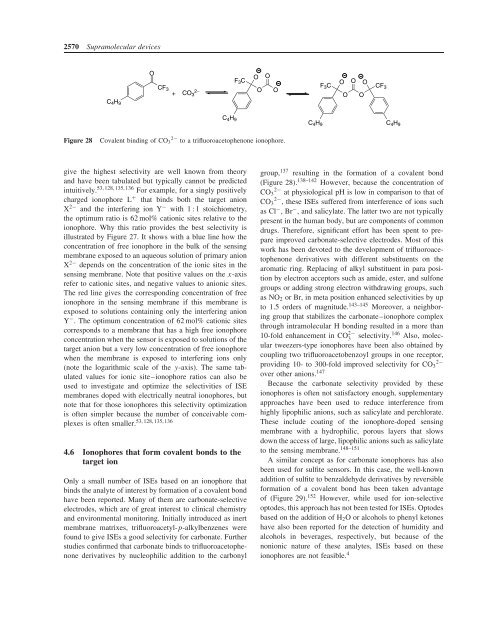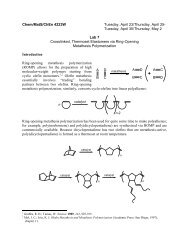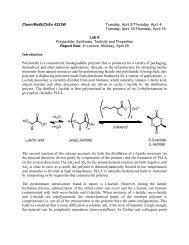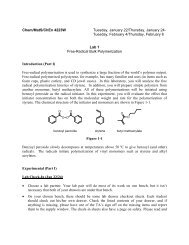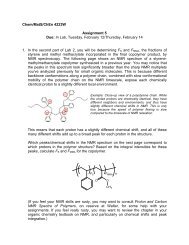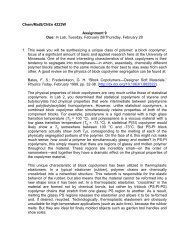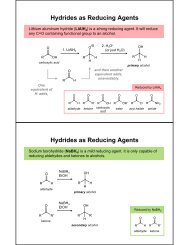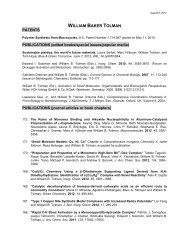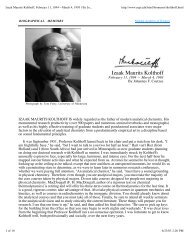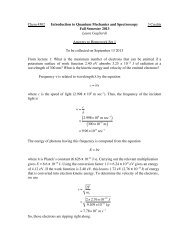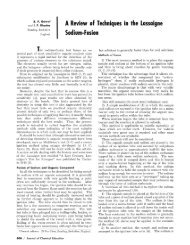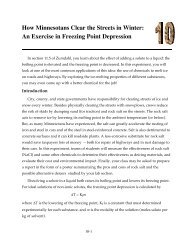Ion-Selective Electrodes With Ionophore-Doped Sensing Membranes
Ion-Selective Electrodes With Ionophore-Doped Sensing Membranes
Ion-Selective Electrodes With Ionophore-Doped Sensing Membranes
You also want an ePaper? Increase the reach of your titles
YUMPU automatically turns print PDFs into web optimized ePapers that Google loves.
2570 Supramolecular devices<br />
C 4 H 9<br />
O<br />
CF 3<br />
+ CO 3<br />
2−<br />
C 4 H 9<br />
F 3 C<br />
O<br />
O<br />
O<br />
O<br />
C 4 H 9<br />
F 3 C<br />
O<br />
O<br />
O<br />
O<br />
O<br />
CF 3<br />
C 4 H 9<br />
Figure 28<br />
Covalent binding of CO 3 2− to a trifluoroacetophenone ionophore.<br />
give the highest selectivity are well known from theory<br />
and have been tabulated but typically cannot be predicted<br />
intuitively. 53, 128, 135, 136 For example, for a singly positively<br />
charged ionophore L + that binds both the target anion<br />
X 2− and the interfering ion Y − with 1 : 1 stoichiometry,<br />
the optimum ratio is 62 mol% cationic sites relative to the<br />
ionophore. Why this ratio provides the best selectivity is<br />
illustrated by Figure 27. It shows with a blue line how the<br />
concentration of free ionophore in the bulk of the sensing<br />
membrane exposed to an aqueous solution of primary anion<br />
X 2− depends on the concentration of the ionic sites in the<br />
sensing membrane. Note that positive values on the x-axis<br />
refer to cationic sites, and negative values to anionic sites.<br />
The red line gives the corresponding concentration of free<br />
ionophore in the sensing membrane if this membrane is<br />
exposed to solutions containing only the interfering anion<br />
Y − . The optimum concentration of 62 mol% cationic sites<br />
corresponds to a membrane that has a high free ionophore<br />
concentration when the sensor is exposed to solutions of the<br />
target anion but a very low concentration of free ionophore<br />
when the membrane is exposed to interfering ions only<br />
(note the logarithmic scale of the y-axis). The same tabulated<br />
values for ionic site–ionophore ratios can also be<br />
used to investigate and optimize the selectivities of ISE<br />
membranes doped with electrically neutral ionophores, but<br />
note that for those ionophores this selectivity optimization<br />
is often simpler because the number of conceivable complexes<br />
is often smaller.<br />
53, 128, 135, 136<br />
4.6 <strong>Ion</strong>ophores that form covalent bonds to the<br />
target ion<br />
Only a small number of ISEs based on an ionophore that<br />
binds the analyte of interest by formation of a covalent bond<br />
have been reported. Many of them are carbonate-selective<br />
electrodes, which are of great interest to clinical chemistry<br />
and environmental monitoring. Initially introduced as inert<br />
membrane matrixes, trifluoroacetyl-p-alkylbenzenes were<br />
found to give ISEs a good selectivity for carbonate. Further<br />
studies confirmed that carbonate binds to trifluoroacetophenone<br />
derivatives by nucleophilic addition to the carbonyl<br />
group, 137 resulting in the formation of a covalent bond<br />
(Figure 28). 138–142 However, because the concentration of<br />
CO 2− 3 at physiological pH is low in comparison to that of<br />
CO 2− 3 , these ISEs suffered from interference of ions such<br />
as Cl − ,Br − , and salicylate. The latter two are not typically<br />
present in the human body, but are components of common<br />
drugs. Therefore, significant effort has been spent to prepare<br />
improved carbonate-selective electrodes. Most of this<br />
work has been devoted to the development of trifluoroacetophenone<br />
derivatives with different substituents on the<br />
aromatic ring. Replacing of alkyl substituent in para position<br />
by electron acceptors such as amide, ester, and sulfone<br />
groups or adding strong electron withdrawing groups, such<br />
as NO 2 or Br, in meta position enhanced selectivities by up<br />
to 1.5 orders of magnitude. 143–145 Moreover, a neighboring<br />
group that stabilizes the carbonate–ionophore complex<br />
through intramolecular H bonding resulted in a more than<br />
10-fold enhancement in CO 2−<br />
3<br />
selectivity. 146 Also, molecular<br />
tweezers-type ionophores have been also obtained by<br />
coupling two trifluoroacetobenzoyl groups in one receptor,<br />
2−<br />
providing 10- to 300-fold improved selectivity for CO 3<br />
over other anions. 147<br />
Because the carbonate selectivity provided by these<br />
ionophores is often not satisfactory enough, supplementary<br />
approaches have been used to reduce interference from<br />
highly lipophilic anions, such as salicylate and perchlorate.<br />
These include coating of the ionophore-doped sensing<br />
membrane with a hydrophilic, porous layers that slows<br />
down the access of large, lipophilic anions such as salicylate<br />
to the sensing membrane. 148–151<br />
A similar concept as for carbonate ionophores has also<br />
been used for sulfite sensors. In this case, the well-known<br />
addition of sulfite to benzaldehyde derivatives by reversible<br />
formation of a covalent bond has been taken advantage<br />
of (Figure 29). 152 However, while used for ion-selective<br />
optodes, this approach has not been tested for ISEs. Optodes<br />
based on the addition of H 2 O or alcohols to phenyl ketones<br />
have also been reported for the detection of humidity and<br />
alcohols in beverages, respectively, but because of the<br />
nonionic nature of these analytes, ISEs based on these<br />
ionophores are not feasible. 4


